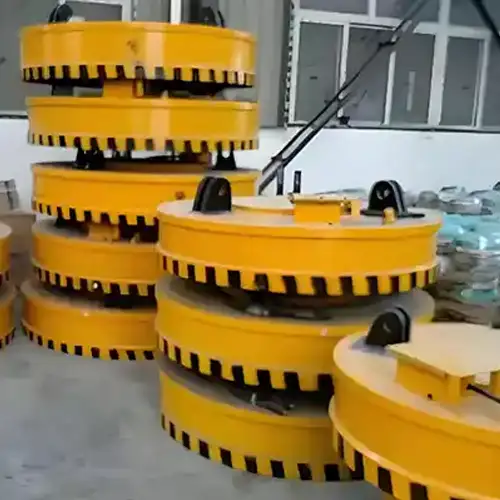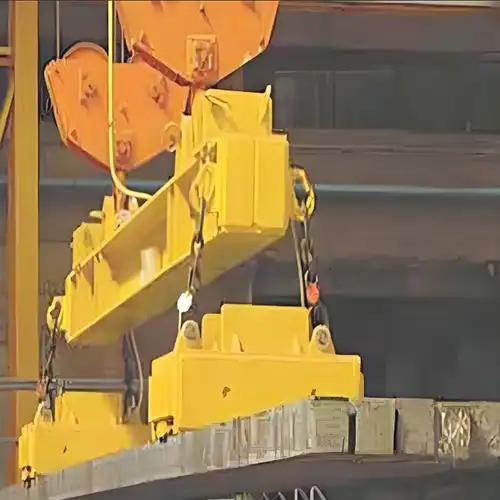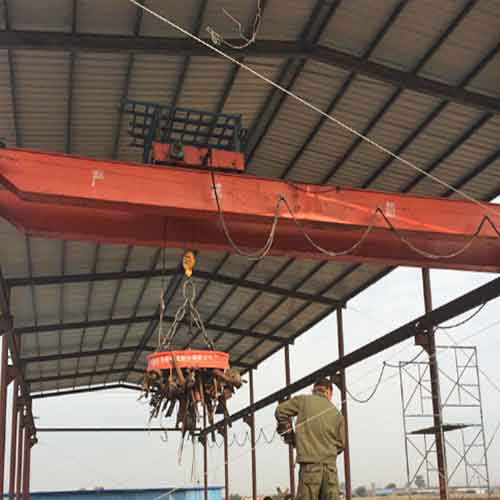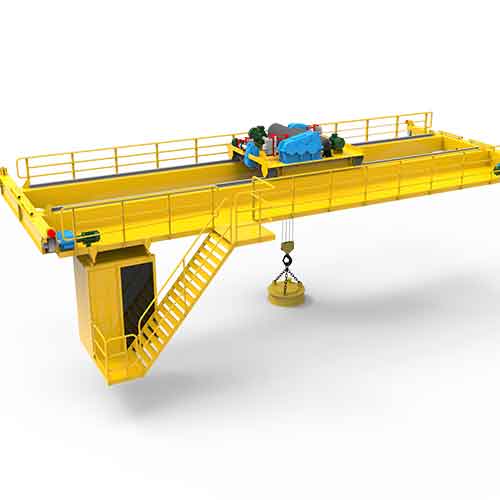Magnetic Electric Cranes For Steel Material Handling 2 to 30 ton
Magnetic overhead cranes and magnetic gantry cranes for various steel material handling with capacities ranging from 2 ton to 30 ton. Chekc now!
Category: Magnetic Crane
Your Trusted Electric Overehad Crane and Gantry Cranes Manufacturer & Supplier
Magnetic Electric Cranes For All Types of Steel Materials Handling 2 to 30 ton
Magnetic overhead cranes and magnetic gantry cranes for various steel material handling with capacities ranging from 2 ton to 30 ton. Chekc now!
Magnetic Cranes Revolutionizing Steel Material Handling
In the steel material handling, traditional methods are making way for groundbreaking innovations, and at the forefront of this transformation are magnetic cranes. These state-of-the-art machines are revolutionizing the efficiency and security of steel handling processes, heralding a new era marked by precision and adaptability. In this exploration, we embark on a journey into the applications of magnetic cranes, aiming to unravel the transformative impact they bring to the steel industry.
Steel material handling poses a myriad of challenges, from the cumbersome manipulation of heavy loads to the delicate handling of intricate steel components. Conventional methods often struggle to strike a balance between efficiency and security. Enter magnetic cranes—an innovation designed to address these challenges head-on.
Magnetic cranes introduce a paradigm shift in the way we approach steel material handling. By harnessing advanced magnetic lifting technology, these cranes redefine the very nature of the process, promising a more streamlined, secure, and efficient method of moving steel objects. The significance lies not only in the technological prowess but in the potential to overcome longstanding hurdles within the steel industry.
At the core of magnetic cranes lies a sophisticated lifting technology that sets them apart. These cranes leverage powerful magnets to create a secure and efficient grip on steel objects, eliminating the need for traditional slings, hooks, or clamps. The magnetic force creates a direct and reliable connection with the steel, ensuring both precision and adaptability in handling various types of steel loads.
The magnetic lifting technology is not just a novel feature; it's a transformative element that brings a level of control and security previously unattainable through conventional means. Let's delve into the applications of this revolutionary technology in the realm of steel material handling.
Magnetic overhead cranes and mangetic gantry cranes
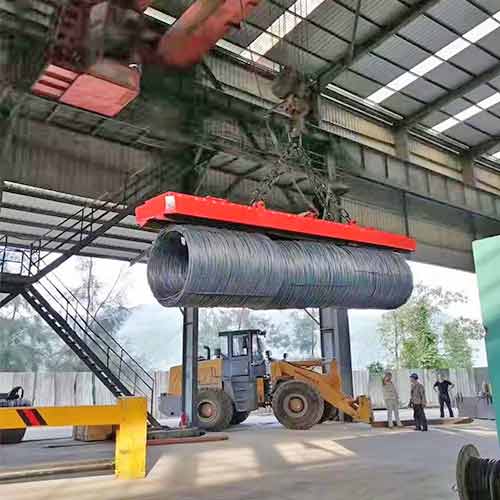
Magnetic Electric Overhead Cranes:
Magnetic overhead cranes are specialized lifting equipment equipped with electromagnetic systems designed to handle ferrous materials, particularly steel. These cranes are commonly found in industrial settings such as steel mills, manufacturing plants, and warehouses where efficient and precise material handling is crucial. The magnetic systems allow these cranes to securely lift and transport steel loads, providing a reliable and versatile solution for various applications.
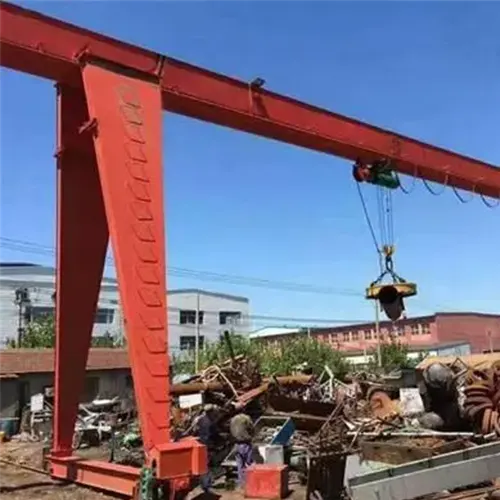
Magnetic Electric Gantry Cranes:
Magnetic gantry cranes share similarities with magnetic overhead cranes but are characterized by a gantry structure that typically includes horizontal beams supported by uprights at both ends. Gantry cranes are suitable for outdoor applications, such as steel yards and construction sites, where overhead support is not available. Like overhead cranes, magnetic gantry cranes are equipped with magnetic systems for efficient steel material handling.
Comparisons: Magnetic Overhead Cranes vs. Magnetic Gantry Cranes:
Structure and Mobility:
Overhead Cranes: Suspended from an overhead runway, providing a clear floor space. Movement is along a fixed path.
Gantry Cranes: Supported by uprights at both ends, allowing movement along a rail on the ground. Offers more flexibility in covering a larger area, especially outdoors.
Application Environment:
Overhead Cranes: Primarily used indoors in manufacturing plants, workshops, and warehouses.
Gantry Cranes: Suited for outdoor applications like steel storage yards, construction sites, and shipyards.
Versatility:
Overhead Cranes: Limited to the designated path of the overhead runway.
Gantry Cranes: More versatile, with the ability to cover a larger area and handle materials in outdoor environments.
Space Utilization:
Overhead Cranes: Maximize floor space as they are suspended overhead.
Gantry Cranes: Use ground space, requiring a clear path along the rail.
Load Handling Capacity:
Overhead Cranes: Available in various load capacities to suit different applications.
Gantry Cranes: Similar load capacities but may have variations based on the specific design.
Indoor vs. Outdoor Use:
Overhead Cranes: Ideal for indoor applications where overhead support is available.
Gantry Cranes: Suited for outdoor applications, providing flexibility in material handling in open spaces.
Cost Considerations:
Overhead Cranes: Installation may involve setting up an overhead runway system.
Gantry Cranes: May be more cost-effective for outdoor applications where an overhead runway is not feasible.
Common Applications:
Overhead Cranes: Commonly used in steel mills, manufacturing plants, and warehouses.
Gantry Cranes: Found in steel yards, construction sites, and locations with outdoor steel material handling needs.
While both types of magnetic cranes serve the purpose of efficiently handling steel materials using magnetic lifting technology, the choice between magnetic overhead cranes and magnetic gantry cranes depends on the specific requirements of the application, available space, and the environmental conditions. Each type offers distinct advantages, making them suitable for different scenarios in the steel material handling industry.
Types of Magnetic Overhead Cranes for Steel Material Handling
Magnetic overhead cranes for steel material handling come in various types, each designed to meet specific needs and applications. Below are some common types, along with their features, applications, and typical below-hook devices:
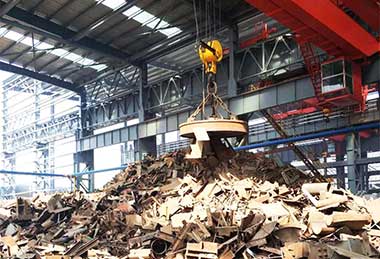
Circular Magnet Electric Crane:
Design: Circular magnets mounted on the crane provide a 360-degree magnetic field, allowing for the lifting of steel objects from any orientation.
Features: Offers versatility in handling steel coils, pipes, and other cylindrical objects without the need for precise alignment.
Applications: Ideal for industries dealing with large volumes of cylindrical steel products, such as metal manufacturing and processing.
Below-Hook Device: Magnetic coil hooks or specialized attachments for handling cylindrical steel loads.

Rectangular Magnet Electric Crane:
Design: Rectangular magnets with adjustable poles provide a powerful and focused magnetic field for lifting flat steel sheets and plates.
Features: Adjustable pole spacing allows customization based on the size and shape of the steel load.
Applications: Well-suited for handling steel plates, sheets, and other flat materials in metal fabrication and steel processing plants.
Below-Hook Device: Magnetic sheet lifters or plate clamps designed for secure handling of flat steel surfaces.

Scrap Handling Magnet Electric Crane:
Design: Specifically designed for the efficient handling of ferrous scrap materials using large, heavy-duty magnets.
Features: High lifting capacity and durability for continuous operation in scrap yards or recycling facilities.
Applications: Primarily used in metal recycling plants for lifting and moving scrap metal.
Below-Hook Device: Heavy-duty magnetic grapples or scrap magnets for effective handling of bulk scrap materials.

Electro-Permanent Magnetic Electric Cranes:
Design: These cranes use a combination of electromagnets and permanent magnets, allowing for both the flexibility of electromagnets and the security of permanent magnets.
Features: The ability to switch between electromagnetic and permanent magnetic modes, reducing the need for continuous power supply during lifting operations.
Applications: Suitable for various steel handling applications where a secure grip is required, including coils, sheets, and structural components.
Below-Hook Device: Electro-permanent magnetic lifters or spreader beams designed for specific steel shapes and sizes.
There are specialized magnetic overhead cranes and magnetic gantry cranes designed specifically for steel material handling. These cranes are equipped with advanced magnetic lifting technology and tailored features to meet the unique demands of the steel industry. Here are some examples of specialized magnetic cranes:

Coil Handling Magnetic Overhead Cranes:
Design: These cranes are specifically designed for the efficient handling of steel coils, which are common in the steel manufacturing and processing industry.
Features: Equipped with specialized coil handling attachments or magnets that provide a secure grip on coils of varying sizes and weights.
Applications: Ideal for lifting, transporting, and stacking steel coils in steel mills and processing plants.

Scrap Yard Magnetic Gantry Cranes:
Design: Tailored for the demanding environment of scrap yards and recycling facilities where handling bulk scrap metal is a primary task.
Features: Heavy-duty magnets and durable construction to withstand the rigors of continuous operation in scrap handling applications.
Applications: Used in metal recycling facilities for efficient handling of ferrous scrap materials.

Plate Lifting Magnetic Overhead Electric Cranes:
Design: Specifically designed for lifting and transporting steel plates and sheets.
Features: Rectangular magnets or vacuum lifting systems to securely hold flat and heavy steel surfaces.
Applications: Commonly used in metal fabrication and steel processing plants for handling steel plates and sheets.

Automated Magnetic Crane Systems:
Design: Integrates magnetic lifting technology with advanced automation and control systems.
Features: Offers automated material handling solutions, including precise positioning, real-time monitoring, and integration with other automated systems.
Applications: Suitable for steel distribution centers, automated warehouses, and high-throughput manufacturing facilities.
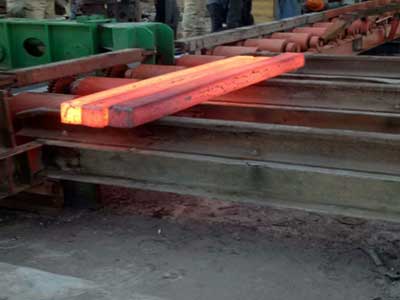
High-Temperature Magnetic Cranes:
Design: Engineered to operate in high-temperature environments, such as steel foundries or hot rolling mills.
Features: Specialized materials and cooling systems to withstand elevated temperatures without compromising performance.
Applications: Used in steel production processes where extreme temperatures are present.

Magnetic Gantry Cranes for Steel Storage:
Design: Gantry cranes with built-in magnetic lifting capabilities for versatile steel storage solutions.
Features: Combines the flexibility of gantry cranes with magnetic lifting technology to handle steel materials both indoors and outdoors.
Applications: Suitable for steel storage facilities, outdoor yards, and warehouses with diverse steel material handling needs.
These specialized categories of load handling by magnetic overhead cranes exemplify the adaptability and efficiency of these lifting solutions across diverse industrial scenarios. Whether operating in extreme temperatures, facilitating the handling of steel coils, or managing the challenges of scrap yards, magnetic overhead cranes play a pivotal role in enhancing material handling processes in the steel industry.
Applications of Magnetic Cranes
Efficient and Secure Steel Handling
In the intricate world of steel material handling, the efficiency and security of the process are paramount. Magnetic cranes emerge as a revolutionary force, streamlining traditional methods and ensuring a level of precision and safety previously unseen.
Exploration of How Magnetic Cranes Streamline Processes in Steel Handling:
Swift Loading and Unloading: Magnetic cranes redefine the speed at which steel objects can be loaded and unloaded. The elimination of manual attachment and detachment processes significantly accelerates these operations, contributing to a more streamlined and efficient workflow.
Reduced Downtime: The direct magnetic connection between the crane and the steel object reduces downtime associated with traditional devices. Operators can swiftly engage and disengage the magnetic force, minimizing the time spent on each handling cycle and maximizing overall productivity.
Enhanced Maneuverability: Magnetic cranes offer enhanced maneuverability due to their ability to precisely control the magnetic field. This feature is particularly beneficial in intricate storage layouts or manufacturing environments where space optimization is crucial.
Case Studies Highlighting Instances of Enhanced Efficiency and Security:
Port Operations Transformation:
In a bustling port environment where time is of the essence, magnetic cranes have revolutionized steel handling operations. Swift loading and unloading of steel cargo have reduced turnaround times for vessels, contributing to increased port efficiency.
Manufacturing Facility Advancements:
Within manufacturing facilities, magnetic cranes have minimized downtime by streamlining the movement of steel components on the production line. The enhanced safety features have also reduced the risk of accidents during handling, creating a safer working environment.
Versatility in Load Handling
Magnetic cranes stand out for their remarkable versatility in handling a diverse range of steel objects, making them indispensable in environments where variability is the norm. The magnetic lifting technology inherent in these cranes provides a secure grip on ferrous materials, allowing for efficient and precise movement without causing damage. Let's delve into the specific steel objects that magnetic cranes adeptly handle:
Demonstrating the Diverse Range of Steel Objects That Magnetic Cranes Can Handle:
Coils and Sheets:
Application: In steel manufacturing and processing plants, magnetic cranes excel in handling steel coils and sheets.
Versatility: The magnetic force ensures a secure grip on these flat and often delicate materials, allowing for precise movement during stacking, unstacking, or transportation. The ability to handle various sizes and thicknesses of coils and sheets makes magnetic cranes invaluable in optimizing material flow.
Structural Components:
Application: Magnetic cranes are instrumental in the construction and metal fabrication industries for lifting and transporting large and irregularly shaped structural components.
Versatility: The adaptability of magnetic cranes extends to the safe and controlled lifting of heavy beams, girders, and other structural elements. The magnetic force provides a uniform hold on these complex objects, ensuring stability during movement and placement. This versatility is crucial in optimizing assembly processes and enhancing overall efficiency in structural steel applications.
Automotive Components:
Application: Magnetic cranes find application in the automotive industry for handling various ferrous components during manufacturing processes.
Versatility: Whether lifting frames, chassis components, or other steel parts, magnetic cranes offer the flexibility required in the automotive sector. The ability to securely hold and maneuver different components contributes to the precision and efficiency of assembly lines, supporting seamless production in the automotive manufacturing environment.
Steel Pipes:
Application: Magnetic cranes are employed in industries involved in the production and distribution of steel pipes.
Versatility: The magnetic lifting technology allows for the secure handling of steel pipes, including long and heavy sections. Magnetic cranes contribute to the efficient movement of pipes within manufacturing facilities, ensuring a smooth flow in production processes.
Metal Sheets:
Application: In metalworking industries, magnetic cranes play a crucial role in handling large metal sheets.
Versatility: The magnetic grip ensures a secure hold on metal sheets, allowing for precision in positioning and movement. This versatility is vital in optimizing cutting, bending, and forming processes, where the controlled handling of metal sheets is essential for achieving accurate results.
The adaptability of magnetic cranes to handle such a diverse array of steel objects underscores their importance in environments characterized by variability and diverse material handling needs. The precise control, secure grip, and versatility of magnetic cranes contribute significantly to the efficiency, safety, and overall operational excellence in industries dealing with a wide range of steel materials.
Application Environments for Magnetic Cranes:
Magnetic cranes are designed to operate in diverse environments, providing versatile solutions for various industrial applications. Here, we explore different application environments and the corresponding designs and applications of magnetic cranes:
Indoor Magnetic Cranes:
Design: Engineered to be suitable for indoor environments with controlled conditions. The cranes are designed to maximize efficiency and safety in manufacturing plants, workshops, and warehouses where steel materials are handled indoors.
Applications: Indoor magnetic cranes are commonly used in manufacturing facilities where precise material handling is essential. They contribute to the streamlined processes within enclosed spaces, ensuring optimal utilization of available floor space.
Outdoor Magnetic Gantry Cranes:
Design: Characterized by robust and weather-resistant structures to withstand outdoor conditions. These cranes are designed for handling steel materials in outdoor yards, offering durability in challenging weather environments.
Applications: Outdoor magnetic gantry cranes are ideal for steel storage facilities, open yards, and construction sites where materials need to be handled in the open air. Their design ensures reliable performance in varying weather conditions.
Dusty or Busy Environments:
Design: Equipped with sealed components and additional safety features to operate efficiently in dusty or busy environments. These cranes are designed to mitigate the impact of dust and ensure safe operation in bustling industrial settings.
Applications: Magnetic cranes designed for dusty or busy environments find applications in steel workshops or fabrication facilities where dust particles are prevalent. The sealed design helps prevent dust infiltration, ensuring the longevity and performance of the crane in such conditions.
These distinct categories of application environments highlight the adaptability of magnetic cranes to meet specific operational needs. Whether operating indoors, outdoors, or in challenging environments with dust or high activity levels, magnetic cranes are engineered to provide efficient and reliable material handling solutions across a spectrum of industrial settings.
Magnetic Overhead Crane for Steel Material handling Across Industrial Sectros
Magnetic overhead cranes are versatile lifting solutions that find applications across various industrial sectors for handling a wide range of steel materials and objects. The magnetic feature of these cranes allows them to securely lift and transport ferrous materials. Here are some typical steel materials or objects that can be handled by magnetic overhead cranes in various industries:
- Steel Coils: Magnetic overhead cranes are commonly used in steel manufacturing and processing plants for handling steel coils. The magnetic lifting technology ensures a secure grip on the coil, allowing for efficient movement and stacking.
- Steel Plates: Cranes equipped with magnetic lifting systems are suitable for handling steel plates in industries such as shipbuilding, construction, and metal fabrication. The magnetic force can be adjusted to accommodate different plate thicknesses.
- Structural Steel Beams: Magnetic cranes are employed in construction and steel fabrication industries for lifting and positioning structural steel beams. The ability to securely hold heavy loads contributes to efficient assembly and construction processes.
- Scrap Metal: Recycling facilities use magnetic overhead cranes to handle ferrous scrap metal. The cranes can efficiently pick up, move, and load scrap materials onto processing equipment, contributing to recycling operations.
- Automotive Components: Magnetic cranes are utilized in the automotive industry for handling steel components such as frames, chassis, and other ferrous parts. The precise control offered by the magnetic system ensures accurate placement of components during manufacturing processes.
- Steel Pipes: Industries involved in the production and distribution of steel pipes use magnetic overhead cranes for handling and transporting pipes of varying sizes. The magnetic feature provides a secure grip, even for long and heavy pipes.
- Metal Sheets: Magnetic cranes are employed in metalworking industries for handling large metal sheets. The ability to lift and move metal sheets with precision enhances the efficiency of cutting, bending, and forming processes.
- Tool and Die Components: Magnetic overhead cranes are suitable for handling tool and die components in manufacturing facilities. The precise control and secure lifting capability aid in the movement of heavy dies and molds.
- Railway Components: Magnetic cranes are used in the railway industry for handling steel components such as rails, sleepers, and other infrastructure materials. The magnetic system ensures safe and efficient material handling in rail yards and maintenance facilities.
- Shipbuilding Materials: Magnetic cranes play a crucial role in shipbuilding yards for handling steel plates, beams, and other components. The ability to lift and maneuver heavy materials contributes to the construction of ship structures.
It's important to note that the specific applications and materials handled by magnetic overhead cranes can vary based on the design and capacity of the crane, as well as the requirements of the industry in which they are deployed.
Customization Options for Adapting to Various Steel Shapes and Sizes:
Adjustable Magnetic Force:
Purpose: Magnetic cranes are ingeniously designed with adjustable magnetic force settings, offering operators the flexibility to tailor the lifting capacity to the specific weight and size of the steel object being handled. This feature ensures precise control over the force exerted during lifting operations.
Versatility: The customization option allows the magnetic force to be precisely tuned, catering to the diverse characteristics of different steel loads. Whether hoisting a substantial structural component or delicately handling a coil, the ability to adjust the magnetic force enhances the crane's adaptability across a wide spectrum of steel shapes and sizes. This versatility is particularly valuable in environments where materials vary significantly.
Modular Lifting Attachments:
Purpose: Many magnetic cranes incorporate modular lifting attachments that are purposefully designed to be adaptable to specific shapes or configurations of steel objects. These attachments enhance the crane's versatility and enable it to efficiently handle various types of steel loads.
Versatility: The utilization of modular lifting attachments ensures that the crane can seamlessly adapt to the unique requirements of different steel loads. Whether dealing with coils, sheets, beams, or other irregularly shaped components, the crane can be equipped with the appropriate attachment, providing a secure and controlled grip. This modular approach significantly broadens the crane's operational capabilities, allowing it to handle a diverse range of steel shapes and sizes without the need for extensive modifications or specialized equipment. The versatility offered by modular lifting attachments contributes to the crane's efficiency in handling complex steel material configurations.
The customization options in magnetic cranes go beyond the conventional, offering a dynamic approach to steel material handling. The adjustable magnetic force settings and modular lifting attachments empower operators to tailor the crane's functionality to the specific needs of each steel load. This adaptability is crucial in environments where variability is the norm, ensuring that the crane can efficiently and securely handle diverse steel shapes and sizes.
As we move forward to Part III, we will unravel the core features of magnetic cranes, delving into the technology that makes them true game-changers in the realm of steel material handling. The journey continues as we explore the innovations that contribute to the efficiency, precision, and safety of magnetic cranes in diverse industrial applications.
Core Features of Magnetic Cranes
In the heart of the magnetic crane revolution lie key features that redefine the landscape of steel material handling. These core elements encompass magnetic lifting technology, control and precision, as well as safety and reliability, collectively elevating magnetic cranes to the forefront of innovation.
Magnetic Lifting Technology
Magnetic lifting technology forms the foundation upon which the transformative capabilities of magnetic cranes rest. This mechanism leverages electromagnetic induction to create a powerful magnetic field, enabling efficient and secure handling of ferrous materials like steel.
Electromagnetic Induction:
Principle: Magnetic cranes are equipped with electromagnets that can be energized or de-energized as needed. The process of electromagnetic induction involves passing an electric current through a coil of wire within the magnet. This, in turn, generates a magnetic field around the coil.
Energized State: When the electromagnets are energized, they create a robust magnetic field. This magnetic field extends beyond the coil, attracting ferrous materials within its range. In the context of magnetic cranes, this means attracting and securely holding onto steel objects.
Direct Magnetic Connection:
Advantage: Unlike traditional lifting devices that often require auxiliary attachments such as hooks or clamps, the magnetic lifting mechanism establishes a direct connection between the crane and the steel object.
Secure and Uniform Grip: This direct magnetic connection ensures a secure and uniform grip on the steel object. The magnetic force acts uniformly across the entire surface of the ferrous material, minimizing the risk of slippage during handling. This characteristic is particularly advantageous when dealing with loads of varying shapes and sizes.
The direct magnetic connection created through electromagnetic induction distinguishes magnetic cranes from conventional lifting equipment. This innovative approach simplifies the lifting process, offering not only a secure grip but also a more straightforward and efficient means of material handling. The elimination of auxiliary attachments streamlines operations and contributes to the versatility and adaptability of magnetic cranes in diverse industrial settings.
How Magnetic Cranes Ensure a Secure Grip on Steel Objects:
The secure grip provided by magnetic cranes is a result of the harmonious interplay of magnetic forces and precision control, ensuring efficient and safe material handling.
Uniform Magnetic Field Distribution:
Design Principle: Magnetic cranes are meticulously designed to distribute the magnetic field uniformly across the surface of the steel object being lifted. This design principle is crucial in ensuring that the entire load is held securely, regardless of its shape, size, or orientation.
Benefits: The uniform magnetic field distribution prevents concentration of forces on specific points of the steel object. This even distribution minimizes the risk of imbalances or uneven lifting, providing a consistent and secure grip. Whether handling flat steel sheets, irregularly shaped components, or cylindrical loads, the uniform magnetic field contributes to stable and controlled lifting.
Adjustable Magnetic Force:
Feature Highlight: Some magnetic cranes incorporate adjustable magnetic force settings as a key feature. This allows operators to customize the lifting capacity based on the weight and dimensions of the specific steel load being handled.
Adaptability: The adjustable magnetic force feature enhances the adaptability of magnetic cranes across various applications. Operators can fine-tune the lifting force to match the characteristics of different steel objects, whether they are heavy structural components, delicate coils, or other diverse loads. This adaptability ensures that the magnetic crane can securely grip and lift a wide range of steel materials without exerting excessive force.
The combination of uniform magnetic field distribution and adjustable magnetic force settings empowers magnetic cranes to handle diverse steel objects with precision and reliability. This dual approach not only ensures a secure grip on the steel load but also allows for customization based on the specific requirements of each lifting operation. As a result, magnetic cranes become versatile assets in industries where variability in steel shapes, sizes, and weights is the norm.
In the upcoming sections, we will explore additional features of magnetic cranes, including their control systems and safety measures, to provide a comprehensive understanding of how these cranes contribute to efficient and secure steel material handling. Stay tuned for more insights into the technological prowess that sets magnetic cranes apart in the realm of industrial lifting equipment.
Control and Precision
Control Systems of Magnetic Cranes:
Control systems in magnetic cranes play a pivotal role in ensuring precision and operational efficiency. The integration of advanced control technologies enhances the capabilities of magnetic cranes, providing operators with the tools needed for seamless material handling.
Remote Control Capabilities:
Enhancing Operator Visibility: Many magnetic cranes come equipped with remote control capabilities, allowing operators to control the crane from a safe distance. This remote operation provides operators with a vantage point that ensures optimal visibility during lifting operations, enabling them to make informed decisions.
Real-time Adjustments: Remote control not only enhances safety by keeping operators at a safe distance from the load but also facilitates real-time adjustments. Operators can adapt to changing conditions, ensuring that the steel objects are handled with precision and efficiency.
Precision in Load Positioning and Movement:
Accurate Manipulation of Magnetic Field: Magnetic cranes exhibit exceptional precision in load positioning and movement. Operators have the ability to manipulate the magnetic field with accuracy, ensuring that steel objects are lifted, moved, and placed with the utmost precision.
Reduction in Errors: The precise control over load positioning and movement contributes to a significant reduction in errors during material handling operations. Whether it's placing a steel coil onto a processing line or positioning structural components in a construction project, the level of control offered by magnetic cranes enhances overall operational efficiency.
The combination of remote control capabilities and precision in load positioning and movement distinguishes magnetic cranes as sophisticated lifting solutions. The integration of advanced control systems not only ensures the safety of operators but also empowers them to handle steel objects with unparalleled accuracy. This level of control is particularly valuable in industries where precision and efficiency are paramount, contributing to streamlined operations and enhanced productivity.
As we continue our exploration of magnetic cranes, the next section will focus on the safety and reliability features that further elevate these cranes as reliable assets in the realm of steel material handling. Stay tuned for insights into the built-in safety mechanisms and the reliability of magnetic cranes in continuous operation.
Safety and Reliability
Examination of Built-In Safety Features in Magnetic Cranes:
Safety is paramount in material handling, and magnetic cranes are designed with a range of built-in features to mitigate risks.
Emergency Braking Systems:
Magnetic cranes often incorporate emergency braking systems that can swiftly halt operations in unforeseen circumstances. This feature minimizes the risk of accidents and enhances the overall safety of steel handling processes.
Reliability in Continuous Operation and Measures to Minimize Downtime:
Magnetic cranes are engineered for reliability in continuous operation. Regular maintenance schedules are complemented by features aimed at reducing downtime. This ensures that these cranes contribute consistently to the efficiency of steel material handling operations.
In conclusion, the core features of magnetic cranes collectively establish them as cutting-edge solutions in steel material handling. The seamless integration of magnetic lifting technology, precision control, and robust safety measures underscores the transformative impact of these cranes. As we continue our exploration, Part IV will delve into the tonnages and handling capabilities of magnetic cranes, showcasing their versatility across a spectrum of steel loads. Stay tuned for a closer look at their impressive lifting capabilities and the adaptability they bring to the steel industry.
Tonnages and Handling Capabilities
In the realm of magnetic cranes, the ability to handle varying tonnages is a critical aspect that speaks to their versatility and adaptability. Understanding the tonnage capabilities of these cranes is pivotal for selecting the right equipment to meet specific steel handling requirements.
Tonnage Capabilities of Magnetic Cranes (2 tons to 30 tons):
2 Tons to 5 Tons:
Magnetic cranes with a lower tonnage capacity, ranging from 2 tons to 5 tons, are well-suited for handling smaller steel loads. These may include components such as individual beams, coils, or smaller structural elements. Their nimble handling makes them ideal for applications where precision and control are paramount.
5 Tons to 15 Tons:
Mid-range magnetic cranes, with tonnage capacities between 5 tons and 15 tons, strike a balance between versatility and power. They are adept at handling a broader spectrum of steel loads, including larger coils, structural elements, or multiple smaller components simultaneously. This range caters to the diverse needs of steel storage facilities and manufacturing environments.
15 Tons to 30 Tons:
High-capacity magnetic cranes, designed to handle loads between 15 tons and 30 tons, are robust solutions for heavy-duty steel handling. They excel in lifting substantial steel structures, large coils, or oversized components. These cranes are instrumental in applications where the weight and dimensions of the steel objects demand a more potent lifting capacity.
Precision Load Planning:
The tonnage options provided by magnetic cranes allow for precise load planning. Operators can match the crane's capacity to the weight of the steel objects being handled, ensuring optimal performance and safety during lifting operations.
Adaptability to Varied Work Environments:
Magnetic cranes, with their diverse tonnage capabilities, are adaptable to varied work environments. Whether it's a small-scale manufacturing setting or a large steel storage facility, the ability to choose the appropriate tonnage ensures that the crane aligns with the specific demands of the operation.
Efficient Resource Utilization:
Selecting the right tonnage for a magnetic crane promotes efficient resource utilization. It prevents overloading or underutilization of the equipment, contributing to overall operational efficiency and longevity of the crane.
Understanding the tonnage capabilities of magnetic cranes is pivotal for making informed decisions in steel material handling. As we continue our exploration, Part V will bring us to the conclusion of our journey, summarizing the transformative impact of magnetic cranes in steel handling processes. Stay tuned for a comprehensive overview that highlights the significance of these cranes and their role in reshaping the future of the steel industry.
Conclusion
As we bring our exploration of magnetic cranes in steel material handling to a close, it becomes evident that these innovative machines are not just technological marvels; they are transformative forces reshaping the very fabric of the steel industry. Let's revisit the transformative applications, emphasize their efficiency, security, and adaptability, and reflect on the revolutionary impact these cranes have on steel handling processes.
Revisiting the Transformative Applications:
- Efficient and Secure Steel Handling: Magnetic cranes have redefined the efficiency and security of steel handling processes. The elimination of manual attachment and detachment, swift loading and unloading, and enhanced maneuverability contribute to a more streamlined and productive workflow.
- Versatility in Load Handling: The diverse range of steel objects that magnetic cranes can handle, from coils to structural components, underscores their versatility. Customization options further enhance their ability to adapt to various steel shapes and sizes, making them indispensable across different applications.
- Precision Control and Remote Operation: Magnetic cranes exhibit precision control in load positioning and movement. With remote control capabilities, operators can oversee operations from a safe vantage point, contributing to enhanced safety and real-time adjustments during lifting operations.
Reflecting on How Magnetic Cranes Revolutionize Steel Handling Processes:
- Efficiency Beyond Conventional Limits: Magnetic cranes push the boundaries of efficiency in steel handling. Their ability to swiftly engage and disengage, coupled with precision control, reduces loading and unloading times to levels beyond what traditional methods can achieve.
- Enhanced Safety and Security: The direct magnetic connection between the crane and the steel object enhances safety by minimizing the risk of slippage or imprecise handling. Built-in safety features, including emergency braking systems, contribute to creating a secure working environment.
- Adaptability to Industry Dynamics: Magnetic cranes are not just tools; they are adaptable solutions that can evolve with the ever-changing dynamics of the steel industry. From port operations to manufacturing facilities, their versatility positions them as strategic assets capable of meeting diverse operational demands.
In shaping the future of the steel industry, magnetic cranes emerge as catalysts for change. Their revolutionary impact extends beyond individual operations; they represent a paradigm shift towards more efficient, secure, and adaptive steel handling processes. As industries seek to optimize resource utilization, minimize downtime, and enhance overall productivity, magnetic cranes stand as beacons of innovation guiding the way forward.
In conclusion, magnetic cranes are not just lifting machines; they are pioneers in the ongoing evolution of steel material handling. As we witness the transformative applications, efficiency gains, and enhanced safety they bring to the table, it's clear that magnetic cranes are instrumental in sculpting a future where the steel industry operates with unprecedented precision and resilience.
Main Projects
Related Products

Supplied three grab bucket crane kits to Indonesia, enhancing garbage handling efficiency with high load capacity and reliable performance.
Free consultation to Confirm Parameters & Specifications and Get
Latest Crane Price & Crane Rate.
- Types of overhead cranes : _______?
- Optional: Overhead travelling crane, goliath gantry crane,Slewing jib crane, Single girder or double girder crane,small portable crane or kbk crane, etc.
- Capacity of overhead crane: _______?
- Optional: 0.25ton, 0.5 ton, 1 ton, 2 ton, 3ton, 5 ton, 10 ton,15ton, 20ton, 25 ton, 30ton,35ton, up to 550ton, etc.
- Crane span & lifting height : _______?
- Crane travelling length : _____?
- Control of overhead crane:_______?
- Optional: pendant/ remote/cabin control
- Voltage supply of overhead crane:_____?
- Eg,: 380V50/60HZ,3Phase or others,etc.
- Application/usage of crane:_______?
- Eg,: Steel mill, ,injection mold, cement,stone, concrete,granite, general manufacturing, etc.
Just leave a message via the contact form and our hoist and crane engineer will contact you with in 24working hours.
Get In Touch




